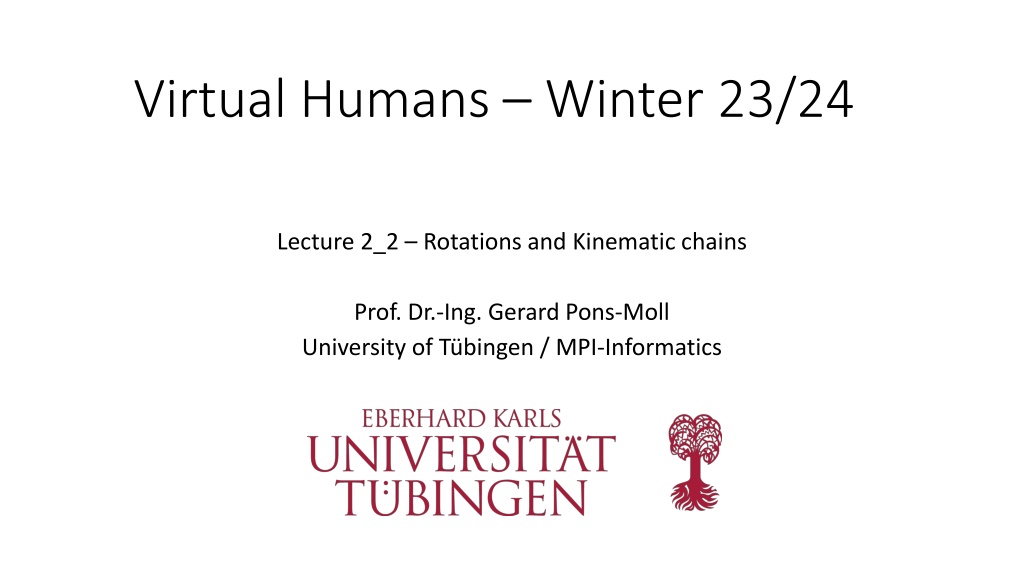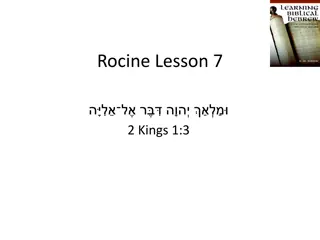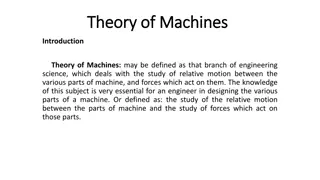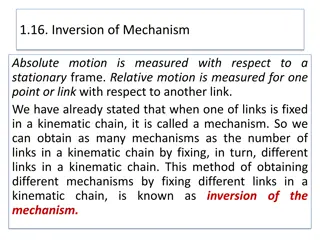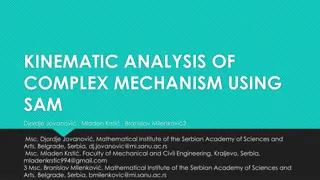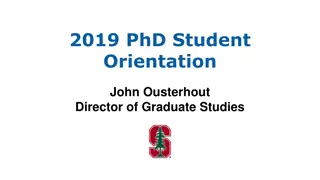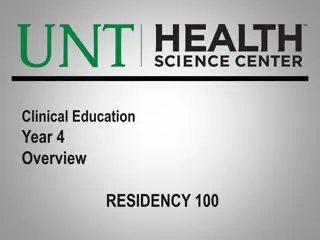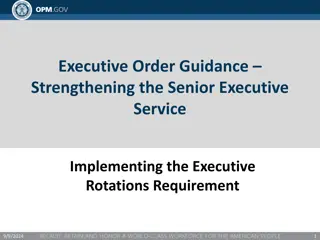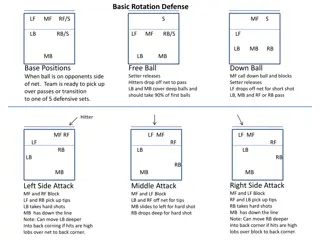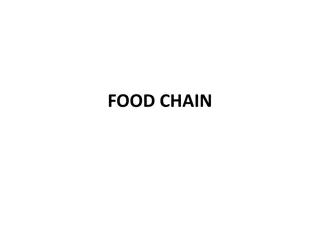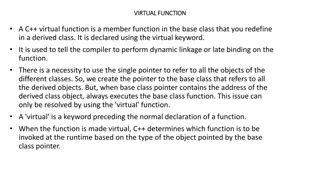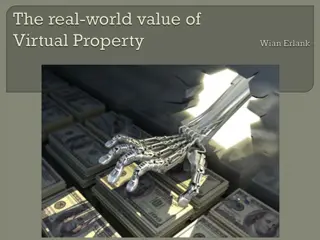Understanding Rotations and Kinematic Chains in Virtual Human Modeling
Exploring the concept of rotations in transformations and the use of kinematic chains in modeling human motion. Topics covered include kinematic parameterization, optimization of rigid body motions, and building virtual human models through kinematic chains. Understanding rotations as linear transformations preserving angles and distances is also discussed, along with the commutativity of rotations in 2D scenarios.
Download Presentation

Please find below an Image/Link to download the presentation.
The content on the website is provided AS IS for your information and personal use only. It may not be sold, licensed, or shared on other websites without obtaining consent from the author. Download presentation by click this link. If you encounter any issues during the download, it is possible that the publisher has removed the file from their server.
E N D
Presentation Transcript
Virtual Humans Winter 23/24 Lecture 2_2 Rotations and Kinematic chains Prof. Dr.-Ing. Gerard Pons-Moll University of T bingen / MPI-Informatics
Ingredients to build a Virtual Human Building a human model Fitting model to observations Kinematic parameterization Rotation Matrices Euler Angles Quaternions Twists and Exponential maps Kinematic chains Inference Observation likelihood Local optimization Particle Based optimization Directly regressing parameters Subject shape model Geometric primitives Detailed Body Scans Human Shape models 2
Kinematic Chains Motivated from robotics: The human motion can be expressed via a kinematic chain , a series of local rigid body motions (along the limbs). The model parameters to optimize, correspond to rigid body motions (RBM). How to model RBM ? 3 Bregler et.al. CVPR-98
Kinematic Parameterization 1) Pose configurations are represented with a minimum number of parameters 2) Singularities can be avoided during optimization 3) Easy computation of derivatives segment positions and orientations w.r.t parameters 4) Human motion contrains such as articulated motion are naturally described 5) Simple rules for concatenating motions 4
Ingredients to build a Virtual Human Building a human model Fitting model to observations Kinematic parameterization Rotation Matrices Euler Angles Quaternions Twists and Exponential maps Kinematic chains Inference Observation likelihood Local optimization Particle Based optimization Directly regressing parameters Subject shape model Geometric primitives Detailed Body Scans Human Shape models 5
Informally, what is a rotation? It is useful to characterize a transformation by its invariances. A rotation is a linear transformation which preserves angles and distances, and does not mirror the object 6
Commutativity of Rotations 3D Try it at home grab a bottle! Rotate 90o around Y, then Z, then X Rotate 90o around Z, then Y, then X Was there any difference? 8
Representing rotations 2D How to get a rotation matrix in 2D? Suppose we have a function S( ), that for a given , gives me the point (x, y) around a circle. What's e1 rotated by ? What's e2 rotated by ? How about u := a.e1 + b.e2? What then must the matrix look like? 9
Rotation Matrices S B The columns of a rotation matrix are the principal axis of one frame expressed relative to another 10
2 Views of Rotations Rotations can be interpreted either as Coordinate transformation Relative motion in time 11
Rotation matrix drawbacks Need for 9 numbers 6 additional constrains to ensure that the matrix is orthonormal and belongs to SO(3) Suboptimal for numerical optimization 12
Euler Angles One of the most popular parameterizations Rotation is encoded as the successive rotations about three principal axis Only 3 parameters to encode a rotation Derivatives easy to compute 13
Euler Angles S 14
Euler Angles: Confusion Careful: Euler angles are a typical source of confusion! When using Euler angles 2 things have to be specified: 1. Convention: X-Y-Z, Z-Y-X, Z-Y-Z 2. Rotations about the static spatial frame or the moving body frame (intrinsic vs extrinsic rotation) 15
Example of intrinsic rotations (z,x,z) https://en.wikipedia.org/wiki/Euler_angles 16
Gimbal Lock When using Euler angles x, y, z, may reach a configuration where there is no way to rotate around one of the three axes! Recall rotation matrices around the three axes: The product of these represents rotation by the three Euler angles. 17
Gimbal Lock Consider the special case where y=?/2 (so, cos( y)=0, sin ( y)=1) We are left with a planar rotation. Notice it depends only of x, z. Not on y. 18
Euler Angles: Drawbacks Gimbal lock: When two of the axis align one degree of freedom is lost! Parameterization is not unique Lots of conventions 19
Complex Analysis - Motivation Natural way to encode geometric transformations in 2D. Simplifies code/notation/debugging/thinking. Moderate reduction in computational cost/ bandwidth/storage. Fluency in complex analysis can lead to deeper/novel solutions to problems 20
Complex Numbers Complex numbers are then just two vectors Instead of e1, e2 use "1" and " " to denote two bases. Otherwise behaves like a 2D space except that we are also going to get a very useful new notation of the product between the two vectors. 22
Complex Arithmetic Same operations as before, plus one more Complex multiplication: Angles add Magnitude multiplies 23
Complex product Polar form Perhaps most beautiful identity in maths. Specialization of Euler's formula. Can use to implement complex product. 25
2D rotations: Matrices vs. Complex Suppose we want to rotate a vector u by an angle , then by an angle . 26
Quaternions generalize complex numbers Q uaternions Q uaternions T L D R : K ind of like c om plex num bers but for 3D rotations T L D R : K ind of like c om plex num bers but for 3D rotations W eird s ituation: c an t do 3D rotations w/ only 3 c om ponents ! TLDR: Kinda like complex numbers but for 3D rotations Weird situation: can't do 3D rotations w/ only 3 components! W eird s ituation: c an t do 3D rotations w/ only 3 c om ponents ! (N ot H am ilton) W illiam R owan H am ilton (1805-1865) C MU 15-462/662 27 (N ot H am ilton) W illiam R owan H am ilton (1805-1865) C MU 15-462/662
Quaternions A quaternion has 4 components: They generalize complex numbers with additional properties: Unit length quaternions can be used to carry out rotations. The set they form is called 28
Quaternions Quaternions can also be interpreted as a scalar plus a 3-vector Where 29
Quaternions Rotations can be carried away directly in parameter space via the quaternion product: Concatenation of rotations: If we want to rotate a vector where is the quat conjugate. 30
Quaternions are ideal for interpolation Interpolating R otations S uppos e we want to s m oothly interpolate between two rotations (e.g., orientations of an airplane) Interpolating E uler angles c an yield s trange-looking paths , non-uniform rotation s peed, Interpolating Euler angles can yield strange-looking paths, non- uniform rotation speed, Simple solution with quaternions: "SLERP" (spherical linear interpolation): S im ple s olution* w/ quaternions : S L E R P (s pheric al linear interpolation): 31 *S hoem ake 1985, A nim ating R otation with Q uaternion C urves C MU 15-462/662
Quaternions Quaternions have no singularities Derivatives exist and are linearly independent Quaternion product allows to perform rotations Good for interpolation But all this comes at the expense of using 4 numbers instead of 3 Enforce quadratic constraint 32
Axis-angle For human motion modeling it is often needed to specify the axis of rotation of a joint Any rotation about the origin can be expressed in terms of the axis of rotation of rotation with the exponential map and the angle 33
Lie Groups / Lie Algebras Definition: A group is an n-dimensional Lie-group, if the set of its elements can be represented as a continuously differentiable manifold of dimension n, on which the group product and inverse are continuously differentiable functions as well M 0 Lie Group M Lie algebra ( ) exp 34
Axis-angle Given a vector the skew symetric matrix is You will also find it as It is the matrix form of the cross-product: 35
Exponential map The exponential map recovers the rotation matrix from the axis-angle representation (Lie-algebra) 36
Exponential map Proof: exponential map ? 37
Exponential map Proof: exponential map 38
Exponential map Proof: exponential map 39
Exponential map Proof: exponential map If we rotate units of time 40
Exponential map Exploiting the properties of skew symetric matrices Rodriguez formula: Closed form! 41
Twists What about translation ? The twist coordinates are defined as And the twist is defined as 42
Exponential map The rigid body motion can be computed in closed form as well From the following formula 43
Which representation should I use? Number of parameters Singularities Human constraints Concatenate motion Optimization (derivatives) Twists Quaternions Twists Quaternions Twists Euler Angles Twists Quaternions Twists Euler Angles Quaternions Euler Angles Euler Angles Euler Angles Quaternions 44
Ingredients to build a Virtual Human Building a human model Fitting model to observations Kinematic parameterization Rotation Matrices Euler Angles Quaternions Twists and Exponential maps Kinematic chains Inference Observation likelihood Local optimization Particle Based optimization Directly regressing parameters Subject shape model Geometric primitives Detailed Body Scans Human Shape models 45
Articulation B S In a rest position we have 46
Articulation S 47
Articulation S 48
Articulation S The coordinates of the point in the spatial frame 49
Product of exponentials is the mapping from coordinate B to coordiante S BUT IS NOT the mapping from segment i+1 to segment i. Think of simply as the relative motion of that joint. 50
